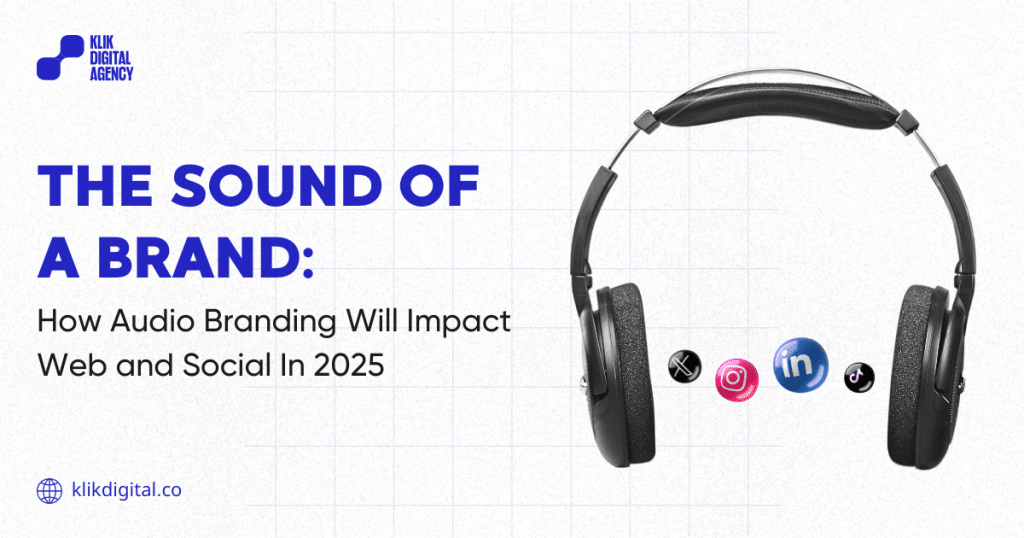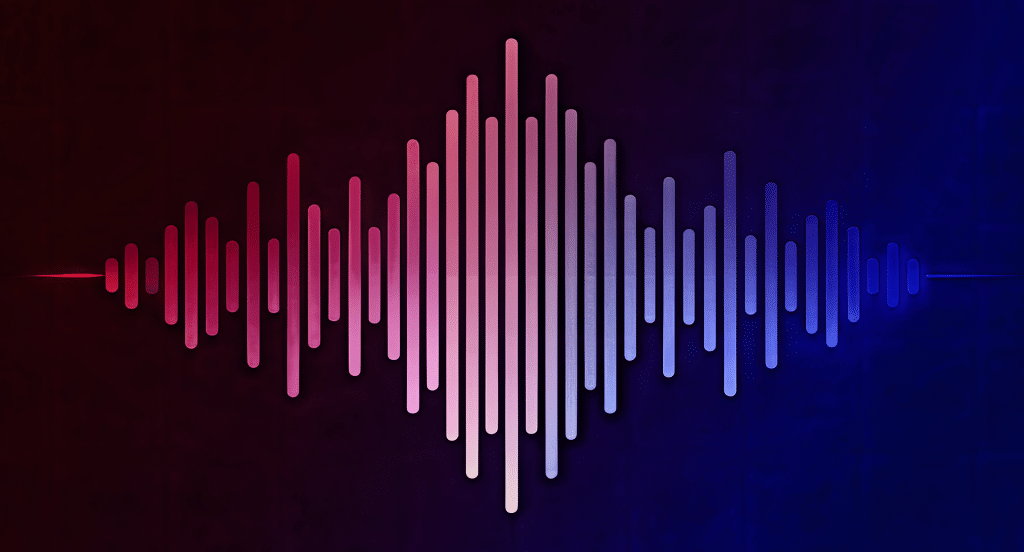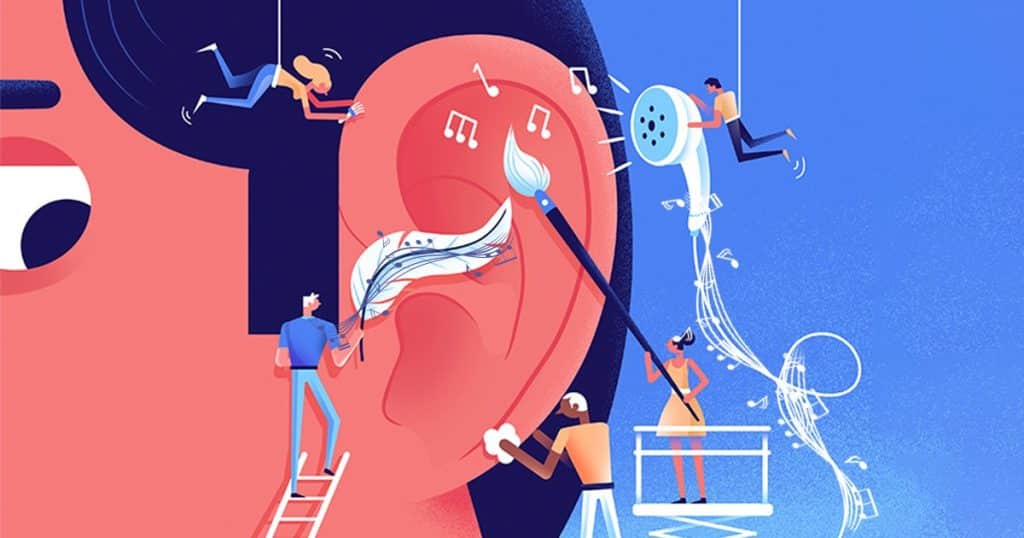The Sound of a Brand: How Audio Branding Will Impact Web and Social in 2026
Subscribe to our newsletter
Keep up with the latest news in the digital marketing arena with Klik Digital. Subscribe Now!
Error: Contact form not found.

Today every brand is screaming for attention. Yours is already fighting for milliseconds of viewing time in a chaotic scroll of visuals. But here’s the thing: visuals are saturated. They’re cheap, they’re everywhere, and your audience is suffering from serious screen fatigue. So, what’s the next frontier for cutting through the noise? It’s time to stop just looking good and start sounding unforgettable.
By 2026, sound will no longer be an afterthought. Rather, it will be a strategic pillar of your digital brand identity. From the moment a user lands on your website to the sound cue confirming a social media purchase, a consistent sonic signature is set to amplify recognition, deepen emotional connection, and fundamentally impact digital brand strategy. If your brand is silent, you’re missing out on the next wave of engagement.
What Is Audio Branding (and Why It’s Now Everywhere)
Audio branding, also known as sonic branding, is the strategic use of sound to define, identify, and promote a brand. It’s more than just music; it’s a systematic approach to using auditory elements across all customer touchpoints.
The key elements of a comprehensive sonic identity include:
- Sonic Logo (or Sound Mark): The short, distinctive sound sequence that immediately identifies your brand, like a musical signature.
- Brand Music (or Theme): Longer musical compositions that convey the brand’s values and tone, often used in corporate videos, podcasts, or advertisements.
- Sound Cues (or Functional Sounds): The non-musical sounds used in user interfaces (UI) to signal events, such as a “new message” alert, a “purchase complete” chime, or a hover sound on a button.
For decades, we relied on memorable jingles to sell products. Today, that has evolved into the realm of sound marketing, where functional sounds and short sonic logos are now seamlessly integrated into the user experience (UX). The goal has shifted from simply entertaining the customer to creating an identifiable, multi-sensory journey.

Why 2025 Is the Year of Sonic Identity
While the concept of audio branding isn’t new, a confluence of technological and cultural trends is making it non-negotiable for digital brands by 2026.
Voice-First Interfaces and AI Normalization
As smart speakers, virtual assistants, and AI-driven interfaces become standard in homes and cars, human-computer interactions shift from screen-based to voice-first. When a customer interacts with your brand via an AI chatbot or digital assistant, the sound of that voice and the associated sonic cues become your brand. A distinct sonic identity is crucial for ensuring recognition and trust in these screenless environments.
The Rise of Sound-Driven Short-Form Video
Platforms like TikTok, Instagram Reels, and YouTube Shorts have fundamentally changed how consumers use content. Sound is the core driver of discovery and engagement; trends are built around specific audio clips or songs. Brands that participate in these spaces must have a robust sound strategy that dictates when to use their own music versus when to integrate into trending audio challenges.
Multi-Sensory Marketing and Emotional Recall
The human brain processes sound faster than images. Sound bypasses the analytical mind and connects directly to the emotional center, triggering strong feelings and memories. By adding a consistent audio layer, brands tap into emotional recall advantages, creating deeper, more durable connections than purely visual marketing ever could.
How Audio Branding Impacts Web Experience
In 2026, your website is no longer a silent brochure. Audio branding transforms the web experience from passive viewing into active engagement, particularly through accessibility and micro-interactions.
Website Sound Cues for Accessibility and Engagement
For users with visual impairments, sound is crucial for navigation. Clear, consistent sound cues can signal successful completion of a form, validation of an input, or navigation to a new page, significantly improving website accessibility and usability.
Micro-Interactions and UX Moments
The small, often unnoticed sounds associated with on-screen actions are key to memorable UX. Think of the subtle click when an item is added to a cart, or a specific tone when hovering over an interactive element. When these micro-interactions use sounds aligned with your core brand identity—instead of generic stock sounds—they create a cohesive, branded experience that reinforces professional quality and attention to detail.

The Role of Audio Branding on Social Media
The social media ecosystem, particularly the short-form video sphere, is where sonic branding is most dynamic and challenging.
Shaping Brand Sound on Short-Form Platforms
A brand’s presence on TikTok and Reels is dictated by sound. Digital brand strategy requires a policy on the use of music:
- Brand-Owned Music: Using your proprietary sonic logo or brand music ensures maximum recognition, even if the user is scrolling rapidly.
- Trend Participation: Strategic involvement in trending audio is necessary for reach. However, a brand should still find ways to integrate its core sonic identity—perhaps by placing the sonic logo at the beginning or end of the video, or by using a recognizable voiceover.
Influencers and Branded Sound Challenges
When collaborating with content creators, clear guidelines must be established regarding audio usage. Brands can launch their own branded sound challenges, incentivizing users to create content using a specific, proprietary brand track. This leverages the viral nature of the platforms while driving recognition back to the brand.
What Makes a Strong Sonic Identity
A strong audio branding strategy is built on two core pillars: Consistency and Emotional Alignment.
Consistency Across Touchpoints
Your sonic identity must be instantly recognizable, whether it’s heard in a pre-roll ad, a website interaction, a podcast intro, or a phone system hold message. This consistent presence builds rapid neural pathways between the sound and your brand.
· Examples:
o Netflix’s “Ta-dum”: A distinct, two-note sound that signals instant recognition, excitement, and the start of premium entertainment.
o Intel’s Five-Note Chime: This short, uplifting melody has been globally consistent for decades, tying the sound directly to high-quality processing and technology.
o McDonald’s “I’m Lovin’ It”: A vocalized sound signature that is adaptable across musical genres but always maintains its core recognition.
Emotional Alignment with Brand Values
The tone, tempo, and instrumentation of your brand sound must accurately reflect your core brand values. Is your brand trustworthy and secure (think deep, low tones)? Is it energetic and innovative (think fast, synthesized melodies)? The sound must emotionally align with the promise you are making to the customer.
How to Develop an Audio Branding Strategy
Developing a sound strategy requires a methodical approach that integrates with existing visual guidelines.
Collaborating with Sound Designers and Creative Strategists
This isn’t a task for an in-house amateur with stock music. You need specialized sound designers who understand psychoacoustics, composition, and the technical requirements of various digital platforms. They collaborate with creative strategists to translate your brand’s mission, vision, and values into a set of distinct, proprietary sounds.
Testing Sound Associations with Target Audiences
Before launch, you must test the sound. Does your target audience associate your chosen sonic logo with the intended emotions (e.g., trust, excitement, calm)? A/B testing variations of sound cues in a prototype UX can prevent a sonic mismatch that could alienate your audience.

Integrating Sonic Branding into Overall Brand Guidelines
The final step is to formalize your audio assets. Your comprehensive brand guidelines must now include a section for sonic branding, detailing:
· The official sonic logo file and approved variations.
· Mandatory volume levels for different platforms (e.g., website vs. podcast).
· A list of approved instrumentation, musical keys, and tempos.
· Guidelines for how brand music can be integrated into social media trends.
The Future: Audio Branding Meets AI and the Metaverse
The frontier of audio marketing 2026 is where sound becomes dynamic, personalized, and spatial.
Generative AI and Dynamic Soundscapes
Generative AI is poised to create music and soundscapes that are context-aware. Imagine the sound on a website’s background subtly changing based on the weather in the user’s location, the time of day, or their behavior on the page. This moves beyond static audio to a personalized, dynamic sound experience.
Voice Branding for AI Chatbots and Digital Assistants
Every brand will need a specific “voice” for its digital assistants. This involves choosing a unique tonality, speaking style, and personality that remains consistent across all customer service and informational touchpoints. The voice is the brand.
Audio branding is no longer a luxury reserved for multinational corporations; it is a fundamental pillar of a forward-thinking digital brand strategy. By 2026, brands without a coherent sonic identity will sound weak and inconsistent.
Don’t let your brand stay silent. Start building your sonic strategy today – reach out to Klik Digital for expert advice!
……………………………………………………………………………………………………..
Frequently Asked Questions (FAQs)

A jingle is a short, memorable song primarily used in advertising with lyrics that often include the product name or sales message. Audio branding (or sonic identity) is a comprehensive system that uses multiple sonic elements (sonic logos, brand music, and sound cues) across all touchpoints—advertising, website UX, chatbots, and social media—to consistently define the brand. A jingle is an ad; a sonic logo is an identity.
If your brand exists in the digital world, interacts with customers via phone or chat, advertises on short-form video platforms (TikTok, Reels), or uses any form of digital content, you need a sonic identity. It becomes essential for any brand seeking to:
- Increase memorability and recall.
- Maintain consistency across screenless interactions (like voice assistants).
- Create a unified, premium user experience.
Yes. While large corporations may invest in extensive custom orchestral pieces, small businesses can start with a proprietary sonic logo (a 1-3 second sound mark) and a simple brand music loop. The cost of one professionally designed sonic logo is a small investment compared to the immense value of consistent brand recognition.
A consistent sonic identity signals professionalism, stability, and attention to detail. When a customer hears the same high-quality, emotionally aligned sound across your website, app, and social ads, it creates a sense of reliability. This consistency reduces cognitive load and fosters customer trust by making the brand feel established and dependable.








